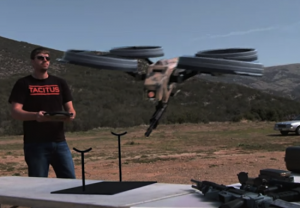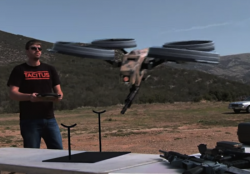
By Chris Rawley
Last winter over at Information Dissemination, I made the observation that swarming robots will irreversibly transform warfare, and I hold to that argument. The discussion and progress in this area is developing quickly. Much of this conversation involves non-military uses for drone technology, but as with many tools, there are also applications for warfare. A host of militarily useful scenarios can be envisioned to employ very small unmanned naval platforms in a non-lethal fashion.
In the videos below, quadrotors are used to perform simple construction tasks. The technology that is today viewed as modern performance art could some day be utilized to build an expeditionary forward operating base remotely. A C-130 would fly over a likely FOB site and deploy hundreds of UAVs, which would quickly go to work filling Hesco Barriers and building fighting positions all night long based on a pre-programmed design, a scoop of sand at a time. Out of power, the drones could then land on the FOB and relay observations to the incoming troops. The site would be defensible as soon as the first Marines arrived, leaving Sea Bees for more valuable construction projects.
A swarm of nano-UUVs similarly equipped as the “coralbots” could quietly infiltrate an enemy naval port and use sensors and algorithms to recognize seawater intakes on ships. These intakes are indispensable on just about every vessel and are used for heat exchangers cooling engines and various pumps, to make fresh water for the crew, and to propel water-jet equipped ships like the LCS. The UUVs could inject a combination of mud or sand scooped up from the harbor with epoxy into these intakes, effectively rendering the fleet useless and unable to get underway. A similar attack could gunk up the intakes to power plants, refineries, and other coastal infrastructure.
Of course, these sorts of aerial swarms might be vulnerable to jamming, EMP, and the like, but here, LT Matt Hipple offers some recommendations to build resiliency into drone swarms. The rapid evolution of drone swarm technology can be expected to continue until concepts like these are deployed operationally; likely sometime in the next decade.
This article was re-posted by permission from NavalDrones.com


One thought on “Dual-Use Drone Swarms”